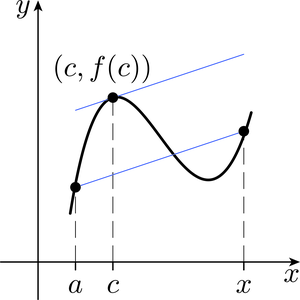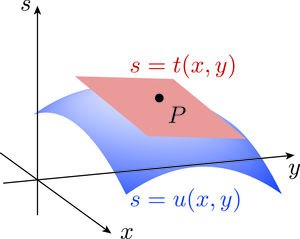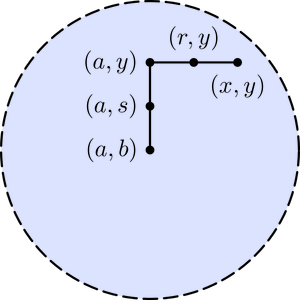2.2 Proof of the Cauchy–Riemann Converse Theorem
The proof of the Cauchy–Riemann Converse Theorem is rather involved and may require more than one reading.
We will need two results from real analysis. The first result is known as the Mean Value Theorem.
Theorem 6 Mean Value Theorem
Let be a real function that is continuous on the closed interval and differentiable on the open interval . Then there is a number such that
To appreciate why this theorem is true, imagine pushing the chord between and in Figure 13 parallel to itself until it becomes a tangent to the graph of at a point , where lies somewhere between and . Clearly, the gradient of the original chord must be equal to the gradient of the tangent, so
Multiplication by gives . Notice that this equation is also true if .
The second result that we will need is a Linear Approximation Theorem, which asserts that if is a real-valued function of two real variables and , then for near , the value of can be approximated by the value of the linear function defined by
Now, the graph of is a plane passing through the point on the graph of (Figure 14). Moreover, the partial - and -derivatives of coincide with the partial - and -derivatives of at . This means that both have the same gradient in the - and -directions, so you can think of the plane as the tangent plane to the graph of at .
The accuracy with which this tangent plane approximates the graph of depends on the smoothness of the graph of . If the graph exhibits the kind of kink shown in Figure 12, then the approximation is not as good as for a function with continuous partial derivatives.
Theorem 7 Linear Approximation Theorem ( to )
Let be a real-valued function of two real variables, defined on a region in containing . If the partial - and -derivatives of exist on and are continuous at , then there is an ‘error function’ such that
where as .
Since is the distance from to , the theorem asserts that the error function tends to zero ‘faster’ than this distance. Theorem 7 is the real-valued function analogue of Theorem 2.
Proof
We have to show that the function defined bysatisfies
Since the partial derivatives exist on , they must be defined on some disc centred at . Let us begin by finding an expression for on this disc. If we apply the Mean Value Theorem to the real functions (where is kept constant) and , then we obtain
where is between and , and
where is between and (see Figure 15). Hence
Substituting this expression for into the definition of , we obtain
Dividing both sides by , and noting that
(because both and do not exceed ), we see that
We are now in a position to prove the Cauchy–Riemann Converse Theorem.
Theorem 5 Cauchy–Riemann Converse Theorem (revisited)
Let be defined on a region containing . If the partial derivatives , , ,
exist at for each
are continuous at
satisfy the Cauchy–Riemann equations at ,
then is differentiable at and
Proof
We need to show that the limit of the difference quotient for at exists and has the value indicated in the theorem. In order to calculate the difference quotient for at , we find an expression for . Since and fulfil the conditions of Theorem 7, it follows thatwhere and are the error functions associated with and , respectively.
Collecting together terms, we see that
Since and satisfy the Cauchy–Riemann equations, both expressions in the large brackets must be equal, so
Dividing by gives
The limit of this difference quotient exists, and has the required value
provided that we can show that the expression involving the error functions and tends to 0 as tends to . To this end, notice that is equal to and so, by the Triangle Inequality,



